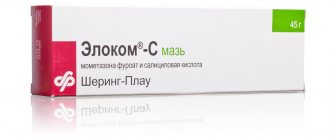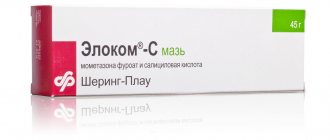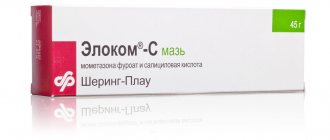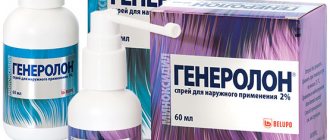Pharmacological properties
Streptocide disrupts the creation of so-called “growth factors” in microorganisms - folic and dehydrofolic acids, and other compounds that have PABA (PABA) in their molecule. Due to the similarity of the structures of PABA and Streptocide, sulfanilamide, as a competitive acid antagonist, is included in the metabolic chain of microorganisms and disrupts metabolic processes in it, which leads to a bacteriostatic effect.
Streptocide is a short-acting sulfonamide that exhibits a bacteriostatic effect against streptococci, meningococci, pneumococci, gonococci, Escherichia coli, pathogens of toxoplasmosis and malaria. Does not affect anaerobic microorganisms.
Pharmacodynamics and pharmacokinetics
Streptocide is an antimicrobial bacteriostatic agent. It acts against pathogenic cocci, Shigella spp., Clostridium perfringens, Corynebacterium diphtheriae, Chlamydia spp., Toxoplasma gondii, Escherichia coli, Vibrio cholerae, Bacillus anthracis, Yersinia pestis, Actinomyces israelii. The medicine promotes accelerated wound healing and epithelization of erosions .
Wikipedia and other sites indicate sulfonamide as a synonym for streptocide . Its chemical name is 4-Aminobenzenesulfonamide and its formula is C6H8N2O2S.
Its action is based on competitive antagonism with PABA , disruption of the synthesis of tetrahydrofolic acid , as well as inhibition of dihydropteroate synthase .
Contraindications
- Sensitivity to sulfonamides, sulfones or other components of the drug;
- A history of severe toxic-allergic reactions to sulfonamides;
- Inhibition of hematopoiesis in the bone marrow;
- Uncompensated heart failure;
- Diseases of the hematopoietic system;
- Anemia;
- Leukopenia;
- Graves' disease;
- Kidney and liver diseases (nephrosis, nephritis, liver failure, severe renal failure, acute hepatitis);
- Hyperthyroidism;
- Congenital deficiency of glucose-6-phosphate dehydrogenase;
- Azotemia;
- Porphyria.
Interaction with other drugs and other types of interactions
When used simultaneously:
- With nonsteroidal anti-inflammatory drugs, sulfonylurea derivatives, anticoagulants, vitamin K antagonists, the effect of these drugs is enhanced;
- With folic acid, bactericidal antibiotics (including penicillins, cephalosporins) - the effectiveness of sulfonamides is reduced;
- With bactericidal antibiotics, oral contraceptives - the effect of these drugs is reduced;
- With PAS and barbiturates - the activity of sulfonamides increases;
- With erythromycin, lincomycin, tetracycline - antibacterial activity is mutually enhanced, the spectrum of action is expanded;
- Rifampicin, streptomycin, monomycin, kanamycin, gentamicin, oxyquinoline derivatives (nitroxoline) - the antibacterial effect of the drugs does not change;
- With nalidixic acid (nevigramon) - antagonism is sometimes observed;
- With chloramphenicol, nitrofurans - the total effect is reduced;
- With drugs containing PABA esters (novocaine, anesthesin, dicaine), the antibacterial activity of sulfonamides is inactivated;
Sulfonamides are not prescribed simultaneously with hexamethylenetetramine (urotropine), with antidiabetic drugs (sulfonylurea derivatives), with definin, neodicoumarin and other indirect anticoagulants.
Streptocide may enhance the effect of methotrexate due to its displacement from protein binding and/or weakening of its metabolism.
When used simultaneously with other drugs that cause bone marrow suppression, hemolysis, or hepatotoxicity, there is a risk of developing toxic effects.
Concomitant use with Methenamine (urotropine) is not recommended due to the increased risk of developing crystalluria due to an acidic urine reaction.
Phenylbutazone (butadione), salicylates and indomethacin can displace sulfonamides from binding to plasma proteins, thereby increasing their concentration in the blood. When used with para-aminosalicylic acid and barbiturates, the activity of sulfonamides increases; with chloramphenicol - the risk of developing agranulocytosis increases; with preparations containing para-aminobenzoic acid esters (novocaine, anesthesin, dicaine), the antibacterial activity of sulfonamides is inactivated.
Analogs
Level 4 ATC code matches:
Dermazin
Argosulfan
Ebermin
The following analogues of the drug are common:
- Streptotsid-Darnitsa;
- Sulfadimezin.
They are sold in tablets. All analogues have their own application characteristics, so before using any of these drugs you should carefully read the instructions.
Features of application
When treating with the drug, it is necessary to systematically monitor renal function and peripheral blood parameters, blood glucose levels.
During long-term treatment with streptocide, it is necessary to periodically conduct blood tests (biochemical and general blood tests). Prescribing the drug in insufficient doses or early discontinuation of the drug may increase the resistance of microorganisms to sulfonamides.
Sulfonamides should not be used to treat infections caused by group A beta-hemolytic streptococcus, since they do not eradicate it and, as a result, cannot prevent complications such as rheumatism and glomerulonephritis.
The drug should be prescribed with caution to patients with chronic heart failure, liver disease and impaired renal function. Streptocide should be prescribed with caution to patients with severe allergic diseases or bronchial asthma, with blood diseases. If signs of a hypersensitivity reaction appear, the drug should be discontinued.
In case of renal failure, accumulation of sulfonamide and its metabolites in the body is possible, which can lead to the development of a toxic effect.
Sulfonamides, including streptocide, should be used with caution in patients with diabetes mellitus, since sulfonamides can affect blood sugar levels. High doses of sulfonamides have a hypoglycemic effect.
Since sulfonamides are bacteriostatic and not bactericidal drugs, a full course of therapy is necessary to prevent relapse of infection and the development of resistant forms of microorganisms.
Given the similarity of chemical structure, sulfonamides should not be used in people with hypersensitivity to furosemides, thiazide diuretics, carbonic anhydrase inhibitors and sulfonylureas.
Patients need to consume sufficient fluids to prevent crystalluria and the development of urolithiasis.
Elderly people have an increased risk of developing severe adverse reactions from the skin, suppression of hematopoiesis, thrombocytopenic purpura (the latter - especially when combined with thiazide diuretics). Prescribing the drug to patients over 65 years of age should be avoided due to the increased risk of severe adverse reactions.
It is recommended to avoid exposure to direct sunlight and artificial ultraviolet irradiation, given the possibility of developing photosensitivity when using sulfonamides.
During treatment, it is necessary to follow the dosage regimen, apply the recommended dose at intervals of 24 hours, and do not skip doses of the drug. If a dose is missed, do not double the next dose.
If the signs of the disease do not begin to disappear or, conversely, the health condition worsens or adverse events occur, it is necessary to stop using the drug and consult a doctor regarding further use of the drug.
Streptocide 300 mg No. 10 tab.
Instructions for medical use of the drug STREPTOCIDE Trade name Streptocide International nonproprietary name Sulfanilamide Dosage form Tablets 300 mg Composition 1 tablet contains the active substance: streptocide (sulfanilamide) 300 mg excipients: potato starch, talc. Description Tablets are white or almost white, in the form of solid, regular, round cylinders, the upper and lower surfaces of which are flat, the edges of the surfaces are beveled, with a scoring line on one side. Pharmacotherapeutic group Antimicrobial drugs for systemic use. Antibacterial drugs for systemic use. Sulfonamides and trimethoprim. Short-acting sulfonamides. Sulfanilamide. ATX code J01E B06. Pharmacological properties Pharmacokinetics When administered orally, it is quickly absorbed - the maximum concentration of streptocide in the blood is observed after 1-2 hours (within 4 hours it is indicated in the cerebrospinal fluid); a 50% reduction in maximum blood concentration occurs in less than 8 hours. Passes through histohematic, including blood-brain (BBB), placental barriers. Distributed throughout the tissues, after 4 hours it is found in the cerebrospinal fluid. In the liver it is acetylated with loss of antibacterial properties. Approximately 95% of the drug is excreted by the kidneys. Pharmacodynamics Streptocide disrupts the formation in microorganisms of so-called “germ factors” - folic, dehydrofolic acids, and other compounds containing para-aminobenzoic acid (PABA) in their molecules. As a result of the proximity of the structures of PABA and Streptocide, sulfanilamide, as a competitive acid antagonist, is included in the metabolic chain of microorganisms and disrupts metabolic processes in it, which leads to a bacteriostatic effect. Streptocide is a short-acting sulfonamide that has a bacteriostatic effect against streptococci, meningococci, pneumococci, gonococci, Escherichia coli, pathogens of toxoplasmosis and malaria. Does not affect anaerobic microorganisms. Indications for use - erysipelas - sore throat - wound infection Method of administration and dosage Take orally during or after meals with 150-200 ml of water. A single dose for adults and children over 12 years of age is 600 mg -1.2 g, the daily dose is 3-6 g. The daily dose is divided into 5 doses. Maximum doses for adults: single dose – 2 g, daily – 7 g. Single dose for children aged 6 to 12 years – 300-600 mg. The frequency of administration for children is 4-6 times a day. The maximum daily dose for children is 0.9-2.4 g. Before prescribing the drug to a patient, it is necessary to determine the sensitivity of the microflora to it that caused the disease in this patient. The duration of treatment is determined by the doctor individually, depending on the severity and course of the disease, the localization of the process, and the effectiveness of therapy. Side effects From the blood and lymphatic systems: leukopenia, agranulocytosis, aplastic anemia, thrombocytopenia, hypoprothrombinemia, eosinophilia, hemolytic anemia due to glucose-6-phosphate dehydrogenase deficiency. From the cardiovascular system: tachycardia, myocarditis. From the nervous system: headache; neurological reactions, including aseptic meningitis; ataxia; slight intracranial hypotension; convulsions; dizziness; drowsiness/insomnia; feeling tired; depression; peripheral or optic neuropathies; visual impairment; psychosis; depressed state; paresthesia. From the respiratory system: pulmonary infiltrates, fibrosing alveolitis. From the digestive tract: thirst, dry mouth, dyspepsia, nausea, vomiting, diarrhea, anorexia, pancreatitis, pseudomembranous colitis. From the hepatobiliary system: increased activity of liver enzymes (ALT, AST, alkaline phosphatase), cholestatic hepatitis, hepatonecrosis, hepatomegaly, jaundice, cholestasis. From the urinary system: change in the color of urine (rich yellow-brown color), crystalluria with an acidic urine reaction; Nephrotoxic reactions are possible: interstitial nephritis, tubular necrosis, renal failure, hematuria, shock kidney with anuria. From the skin and subcutaneous tissue: skin hyperemia, skin rash (including erythematous-squamous, papular), itching, urticaria, allergic dermatitis, photosensitivity, exfoliative dermatitis, erythema nodosum, cyanosis. Allergic reactions: toxic epidermal necrolysis (Lyell's syndrome), Stevens-Johnson syndrome, systemic lupus erythematosus, serum syndrome, anaphylactic reactions, Quincke's edema, runny nose. General disorders: drug-induced fever, pain in the right hypochondrium and lower back. Other: difficulty breathing, periarteritis nodosa, hypothyroidism, hypoglycemia. In isolated cases, the development of hypothyroidism is possible. Contraindications - Individual sensitivity to sulfonamides, sulfone or other components of the drug; - a history of severe toxic-allergic reactions to sulfonamides; - inhibition of bone marrow blood formation; - decompensated heart failure; - diseases of the hematopoietic system; - anemia; - leukopenia; - Graves' disease; - kidney and liver diseases (nephrosis, nephritis, liver failure, severe renal failure, acute hepatitis); - hyperthyroidism; - congenital deficiency of glucose-6-phosphate dehydrogenase; - azotemia; - porphyria; - children under 6 years old; - women during lactation and pregnancy. Drug interactions When used simultaneously: – with non-steroidal anti-inflammatory drugs, sulfonylurea derivatives, antithrombotic agents, vitamin K antagonists – the effect of these drugs is enhanced; – with folic acid, bactericidal antibiotics (including penicillins, cephalosporins) – the effectiveness of sulfonamides is reduced; – with bactericidal antibiotics, oral contraceptives – the effect of these drugs is reduced; – with PAS and barbiturates – the activity of sulfonamides increases; – with erythromycin, lincomycin, tetracycline – antibacterial activity is mutually enhanced, the spectrum of action is expanded; – with rifampicin, streptomycin, monomycin, kanamycin, gentamicin, oxyquinoline derivatives (nitroxoline) – the antibacterial effect of the drugs does not change; – with nalidixic acid (nevigramon) – antagonism is sometimes observed; – with chloramphenicol, nitrofurans – the total effect is reduced; – with drugs containing PABA esters (novocaine, anesthesin, dikamine), – the antibacterial activity of sulfonamides is inactivated. Sulfonamides are not prescribed simultaneously with hexamethylenetetramine (urotropine), with antidiabetic drugs (sulfonylurea derivatives), with definin, neodicoumarin and other indirect anticoagulants. Streptocide may enhance the effect and/or toxicity of methotrexate as a result of displacing it from protein binding and/or weakening its metabolism. When used simultaneously with other drugs that cause bone marrow suppression, hemolysis, or hepatotoxicity, there may be a risk of developing toxic effects. Concomitant use with methenamine (urotropine) is not recommended due to the increased risk of developing crystalluria due to acidic urine. Phenylbutazone (butadione), salicylates and indomethacin can displace sulfonamides from binding to plasma proteins, thereby increasing their concentration in the blood. When used together with para-aminosalicylic acid and barbiturates, the activity of sulfonamides increases; with chloramphenicol – the risk of developing agranulocytosis increases; with drugs containing para-aminobenzoic acid esters (novocaine, anestezin, dicaine), the antibacterial activity of sulfonamide is inactivated. Special instructions When treating with the drug, it is necessary to systematically monitor renal function and peripheral blood parameters, blood glucose levels. During long-term treatment with the drug, it is necessary to periodically conduct blood tests (biochemical and general blood tests). Prescribing the drug in insufficient doses or premature discontinuation of the drug may increase the resistance of microorganisms to sulfonamides. Sulfonamides should not be used to treat infections caused by group A beta-hemolytic streptococcus, since they do not lead to its eradication and, as a result, cannot prevent complications such as rheumatism and glomerulonephritis. The drug should be prescribed with caution to patients with chronic heart failure, liver disease and impaired renal function. Streptocide should be prescribed with caution to patients with severe allergic diseases or bronchial asthma, with diseases of the blood system. If signs of a hypersensitivity reaction appear, the drug should be discontinued. In case of renal failure, accumulation of sulfonamide and its metabolites in the body is possible, which can lead to the development of a toxic effect. Sulfonamides, including streptocide, should be used with caution in patients with diabetes mellitus, since sulfonamides can affect blood sugar levels. High doses of sulfonamides have a hypoglycemic effect. Since sulfonamides are bacteriostatic and not bactericidal drugs, a full course of therapy is necessary to avoid relapse of infection and the development of persistent forms of microorganisms. Given the similarity of the chemical structure, sulfonamides should not be used in people with hypersensitivity to furosemide, thiazide diuretics, carbonic anhydrase inhibitors and sulfonylureas. Patients need to drink enough fluids to avoid crystalluria and the development of urolithiasis. In elderly patients, there is an increased risk of developing severe adverse reactions from the skin, inhibition of blood formation, and thrombocytopenic purpura (the latter, especially in combination with thiazide diuretics). Prescribing the drug to patients over 65 years of age should be avoided due to the increased risk of severe adverse reactions. It is recommended to avoid exposure to direct sunlight and artificial ultraviolet irradiation, given the possibility of developing photosensitivity when using sulfonamides. During treatment, it is necessary to adhere to the dosage regimen, apply the recommended dose at intervals of 24 hours, without skipping doses of the drug. If a dose is missed, do not double the next dose. If the signs of the disease do not begin to disappear or, conversely, the health condition worsens or adverse events occur, it is necessary to stop using the drug and consult a doctor about the possibility of further use of the drug. Children Do not use in children under 6 years of age. Use during pregnancy or breastfeeding During pregnancy or breastfeeding, the drug is contraindicated. If treatment with the drug is necessary, breastfeeding should be stopped. Features of the effect of the drug on the ability to drive a vehicle or potentially dangerous mechanisms Until the individual reaction to the drug is determined, you should refrain from driving vehicles or operating other mechanisms, since during treatment with sulfonamides, adverse reactions from the nervous system such as dizziness, convulsions, ataxia are possible , drowsiness, depression, psychosis. Overdose Possible increased side effects. In case of an overdose, anorexia (lack of appetite), nausea, vomiting, colicky pain, headache, drowsiness, dizziness, and fainting may occur. With long-term use, fever, hematuria, crystalluria, cyanosis, tachycardia, paresthesia, diarrhea, cholestasis, renal failure with anuria, toxic hepatitis, leukopenia, agranulocytosis are possible. Treatment. In case of overdose, it is recommended to consult a doctor. Treatment is symptomatic. Before providing medical care, rinse the stomach with a 2% sodium bicarbonate solution and take a suspension of activated charcoal or other enterosorbents. Drinking large amounts of fluid, forced diuresis, and hemodialysis are indicated. Release form and packaging 10 tablets are placed in a blister pack made of polyvinyl chloride film and aluminum foil. Contour cell packaging, together with instructions for medical use in the state and Russian languages, are placed in boxes made of chrome-ersatz recycled or boxed cardboard or in boxes made of corrugated cardboard. The number of instructions in a group package is included in the number of packages. Storage conditions Store in original packaging at a temperature not exceeding 25 °C. Keep out of the reach of children. Shelf life: 5 years. Do not use after the expiration date. Conditions for dispensing from pharmacies By prescription Manufacturer/Packager PJSC “Lubnyfarm”, Ukraine, 37500, Poltava region, Lubny, st. Barvinkova, 16. Owner of the registration certificate of PJSC "Lubnyfarm", Ukraine, 37500, Poltava region, Lubny, st. Barvinkova, 16. Name, address and contact details of the organization on the territory of the Republic of Kazakhstan that accepts claims (suggestions) on the quality of medicines from consumers and is responsible for post-registration monitoring of the safety of the medicine: Pharmaline LLP, 050016, Almaty, st. Shamieva, 11,
Application of Streptocide
Take orally during or after meals with 150-200 ml. water. A single dose for adults and children over 12 years of age is 600 mg-1.2 g, the daily dose is 3-6 g. The daily dose is divided into 5 doses. Maximum doses for adults: single -2 g, daily -7 g.
A single dose for children aged 3 to 6 years - 300 mg, from 6 to 12 years - 300 mg-600 mg. The frequency of administration for children is 4-6 times a day.
The maximum daily dose for children is 900 mg-2.4 g.
The duration of treatment is determined by the doctor individually, depending on the severity and course of the disease, the localization of the process and the effectiveness of therapy.
Streptocide price, where to buy
This product is considered very affordable. So the price of ointment in pharmacies is about 20 rubles. And the cost of the powder may depend on the form of release. It can be bought in a bottle, jar, or bags. The price of Streptocide powder in a bottle or jar is approximately 40 rubles. And the cost of the product in packages is about 30 rubles. The price of Streptocide in tablets is not indicated anywhere, since this product has not been on sale since 2008.
- Online pharmacies in RussiaRussia
- Online pharmacies in UkraineUkraine
- Online pharmacies in KazakhstanKazakhstan
ZdravCity
- Streptocide por.
for outdoor approx. 2 State LLC "Aromasintez" 19 rub. order - Streptocide powder for external use package 5g JSC Yaroslavskaya f.f.
49 RUR order
- Streptocide powder for external use. approx. 2g LumiLumi LLC
17 RUR order
- Streptocide powder for external use. approx. 2gZAO FP Meligen
23 RUR order
- Streptocide soluble liniment d/nar. approx. 5% 30 JSC Usolye-Sibirsky Chemical Pharmaceutical Plant
73 rub. order
Pharmacy Dialogue
- Streptotsid (por. 2g No. 1) Tula FF
17 RUR order
- Streptocide (por. 10 g (dose)) Doctor
89 rub. order
- Streptocide (por. 2g No. 1) Ivanovskaya Pharm. f-ka.
12 RUR order
- Streptotsid (por. 2g No. 1) Meligen FP CJSC
20 rub. order
- Streptocide ointment (can 10% 25g) Tula FF
99 RUR order
show more
Pharmacy24
- Streptocide ointment 10% 25 g Ternofarm TOV, m. Ternopil, Ukraine
8 UAH. order - Streptocide ointment 10% 25 g tube PAT "Lubnifarm", Ukraine
9 UAH order
- Streptocid 0.3 g N10 tablets Ternopharm TOV, Ternopil, Ukraine
3 UAH order
- Streptocidal ointment 10% 25 g PrAT FF "Viola", Ukraine
9 UAH order
- Streptocidal ointment 10% 25 g PrAT FF "Viola", Ukraine
11 UAH order
PaniPharmacy
- Streptocide ointment Streptocide ointment 10% 25g Ukraine, Lubnyfarm PJSC
10 UAH.order
- Streptocide tablets Streptocide tablets. 0.5g No. 10 Ukraine, Ternopharm LLC
6 UAH order
- Streptocide tablets Streptocide tablets. 0.3g No. 10 Ukraine, Ternopharm LLC
3 UAH order
- Streptocide ointment Streptocide ointment 5% 25g ind. pack Ukraine, Viola FF CJSC
11 UAH order
- Streptocid tablets Streptocid tablets 0.3g No. 10 Ukraine, Darnitsa ChAO
5 UAH order
show more
Overdose
Side effects may increase.
In case of an overdose, anorexia (lack of appetite), nausea, vomiting, colicky pain, headache, drowsiness, dizziness, and fainting may occur. With long-term use, fever, hematuria, crystalluria, cyanosis, tachycardia, paresthesia, diarrhea, cholestasis, renal failure with anuria, toxic hepatitis, leukopenia and agranulocytosis are possible.
In case of overdose, it is recommended to consult a doctor. Treatment is symptomatic. To provide medical assistance, rinse the stomach with a 2% sodium bicarbonate solution and take a suspension of activated carbon or other enterosorbents. Drinking plenty of fluids, forced diuresis, and hemodialysis are indicated.
Adverse reactions
From the blood and lymphatic system:
leukopenia, agranulocytosis, aplastic anemia, thrombocytopenia, hypoprothrombinemia, eosinophilia, hemolytic anemia due to glucose-6-phosphate dehydrogenase deficiency.
From the cardiovascular system:
tachycardia, myocarditis.
From the nervous system:
headache; neurological reactions, including aseptic meningitis; ataxia; minor intracranial hypotension, seizures; dizziness; drowsiness/insomnia; feeling tired; depression; peripheral or optic neuropathies; visual impairment; psychosis; depressed state; paresthesia.
From the respiratory system:
pulmonary infiltrates, fibrosing alveolitis.
From the digestive tract:
thirst, dry mouth, dyspepsia, nausea, vomiting, diarrhea, anorexia, pancreatitis, pseudomembranous colitis.
From the digestive system:
increased activity of liver enzymes (AJIT, ACT, alkaline phosphatase), cholestatic hepatitis, hepatonecrosis, hepatomegaly, jaundice, cholestasis.
From the urinary system:
change in urine color (deep yellow-brown color), crystalluria due to acidic urine reaction; possible nephrotoxic reactions: interstitial nephritis, tubular necrosis, renal failure, hematuria, shock kidney with anuria.
From the skin and subcutaneous tissue:
skin hyperemia, skin rashes (including erythematous-squamous, papular), itching, urticaria, allergic dermatitis, photosensitivity, exfoliative dermatitis, erythema nodosum, cyanosis.
Allergic reactions:
allergic reactions, including toxic epidermal necrolysis (Lyell's syndrome), Stevens-Johnson syndrome, systemic lupus erythematosus, serum syndrome, anaphylactic reactions, Quincke's edema, runny nose.
General violations:
drug fever, pain in the right hypochondrium and lower back.
Other:
difficulty breathing, periarteritis nodosa, hypothyroidism, hypoglycemia. In rare cases, hypothyroidism may develop.



